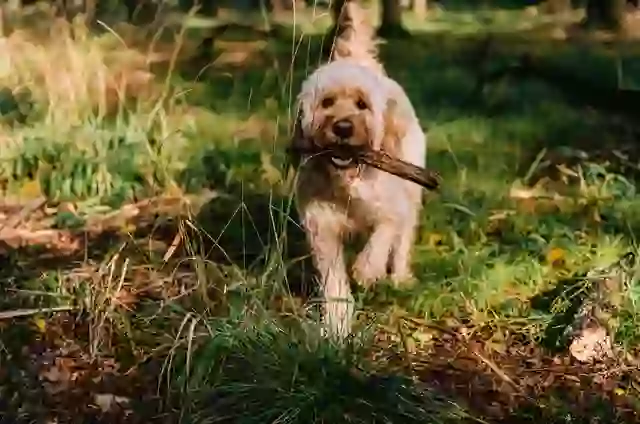Vet Shares The Hidden Dangers Of Throwing Sticks For Dogs
Think about the last time you watched your dog sprint off, tongue lolling in delight, as you hurled a stick across the park. It seems harmless, even a classic way to play, but veterinarians have been raising the alarm about this time-honored game. What feels like innocent fun can quickly become a serious emergency for your furry friend.
Most of us have seen dogs chomping on sticks and assumed it’s no different from gnawing on a chew toy. However, veterinary nurse Jade on TikTok shared a harrowing story that illustrates how dangerous it can be.
She warns that when you fling a stick, it sometimes buries itself in the ground. Your dog, charging headlong to catch it, can slam right into that embedded stick and impale themselves through the roof of their mouth. Jade describes one tragic case: the stick pierced the dog’s hard palate, traveled into its brain, and caused immediate death.
As if that weren’t alarming enough, splintering is another serious hazard. Sharp fragments can slice into your dog’s gums, lodge in their throat, or even puncture the stomach lining.
Imagine your dog swallowing a jagged piece of wood that later cuts the inside of their digestive tract; that’s a recipe for painful infections, internal bleeding, and emergency surgery.
Jade admits she’s seen multiple fatalities and countless injuries stemming from stick play, and she cringes whenever she spots a well-meaning owner tossing sticks for their pet.
Letting your dog chew on sticks can spell trouble.
Charities like Blue Cross back up her warning. They note that sticks can cause splinters in the gums, choking hazards when bits break off, blocked intestines, eye scratches, puncture wounds on the body, and bacterial infections if the wood is contaminated.
Even a small scratch in the mouth can lead to a severe infection if soil or bacteria ride in on the wood.

Sticks can pose serious risks to dogs.
So why are dogs so irresistibly drawn to sticks? Blue Cross points out that sticks are “multi-sensory” objects: each one carries a different smell, texture, taste, and shape.
Chewing a stick can soothe teething or gum soreness, and the natural grooves make them feel satisfying to nibble. Unfortunately, that appeal can hook them into a dangerous habit.
Occasional chewing can evolve into a lifelong fixation that keeps them gnawing on whatever wood they find, regardless of size, shape, or cleanliness.

Blue Cross has outlined the associated health risks.
Thankfully, plenty of safer alternatives allow your dog to indulge their instincts and burn off energy. Fetch games work just as well with sturdy rubber balls made for dogs; pick a size too large to swallow, and your pooch can chase without the risk of tearing into their mouth or breaking the toy into sharp shards.
Rope toys offer a satisfying tug-and-chew experience without the splinter hazard, and many manufacturers even make rubber “sticks” that look real but won’t splinter or puncture.

Veterinary Perspectives on Stick Play
Dr. Julie Buzby, a veterinarian and founder of ToeGrips, emphasizes the risks associated with throwing sticks for dogs. While it seems like a fun activity, she warns that sticks can splinter and cause serious injuries, such as punctured intestines or oral lacerations.
Dr. Buzby advises pet owners to consider safer alternatives, such as rubber fetch toys or specially designed dog sticks that won't splinter. These alternatives provide the same enjoyment without the associated risks, ensuring your dog's playtime remains safe and fun.
A canine behaviorist, Dr. Patricia McConnell, highlights that dogs often chase sticks due to their instinctual prey drive. However, this behavior can lead to not only physical dangers but also behavioral issues, like anxiety from chasing after something that might hurt them.
To mitigate these risks, Dr. McConnell suggests incorporating interactive toys that engage your dog’s mind while keeping them safe. Engaging your dog with puzzle toys or playing fetch with soft, durable balls can provide mental stimulation and physical exercise without the potential hazards of sticks.
When choosing a substitute, look for toys that are durable, easy to clean, and free of small parts that could break off. Introduce these new toys with plenty of praise and encouragement so your dog learns they’re just as much fun, if not more so, than natural sticks.
A quick game of fetch with a bright rubber stick can spark the same excitement without any hidden dangers. At the end of the day, our goal is simple: keep playtime joyful and injury-free.
Recognizing the hidden dangers of throwing sticks for dogs is crucial for their safety. Experts like Dr. Buzby and Dr. McConnell provide valuable insights into alternative play methods that can keep our furry friends safe. By opting for safer toys designed specifically for dogs, we can help prevent injuries and promote healthy play.
Additionally, understanding the behavioral instincts that drive our dogs' actions can aid in selecting appropriate toys that cater to their natural tendencies. Ultimately, prioritizing safety in playtime leads to happier and healthier pets.



